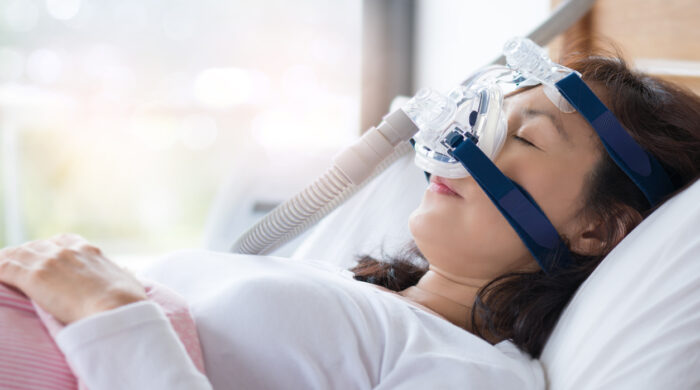According to sleepapnea.org, over 20 million Americans suffer from the sleep disorder known as sleep apnea. This potentially life-threatening ailment happens when the throat pathway narrows due to muscles relaxing so much during sleep that oxygen cannot pass through.
If lifestyle changes such as losing weight, quitting smoking and sleeping on your side don’t eliminate your symptoms, a doctor may prescribe the use of a Continuous Positive Airway Pressure (CPAP) machine. In this post, we’ll examine how CPAP therapy works, what exactly CPAP treats and recommendations for who should seek this method of therapy.
What is CPAP therapy?
CPAP therapy is the practice of sending more air pressure through your system than you’d naturally inhale on your own. By forcing this additional, continuous air flow through your system, moments of oxygen deprivation can be avoided, and a more restful night of sleep can occur.
Better sleep can have multiple health benefits such as improved brain function and sharper memory, weight loss, clear skin, stress reduction, cancer prevention, inflammation reduction and more.
How CPAP Works
CPAP therapy involves wearing a CPAP mask while you sleep or nap, which is placed over or fits into your nose and hooks up via a tube to a machine. That specialized machine then delivers the pressurized air.
The good news is that there are several different devices on the market that can help. Here are the most common varieties:
- A Nasal Pillow Mask is ideal for you if you suffer from claustrophobia, if you need your field of vision free for reading or other nighttime activities or if you have facial hair that is disturbed by a traditional mask.
- A Nasal Mask that simply covers the nose is better if you have a higher-pressure setting prescribed by your doctor. It can also be effective you are an active sleeper and move around repeatedly through the night.
- A Full Face Mask is a good solution if you suffer from congestion or other nasal obstructions that prevent easy breathing through the nose.
Other things to consider when searching for the best mask for your needs are size, materials they are made from, noise level, cost, pressure settings and shape.
What CPAP Treats
There are two different kinds of sleep apnea: Obstructive Sleep Apnea, which occurs during sleep when your upper airway becomes blocked over and over again and reduces or restricts air flow. Central Sleep Apnea happens when your brain fails to send the necessary signals to breathe.
Both conditions are often treated with CPAP therapy. Short-term positive benefits of using the CPAP machine can include less daytime sleepiness, reduction or elimination of snoring and end to the sleep events that wake you up throughout your slumber. Long-term benefits of CPAP therapy may include lower blood pressure, stroke and heart attack prevention, diabetes risk reduction and cognitive function improvements.
Negative side effects of CPAP therapy can include runny nose, dry mouth, nosebleeds or congestion. The masks can sometimes also cause skin irritation, which is why it’s so important to find one that fits your face well. In more rare cases, stomach issues and bloating can also result. Be sure to report any negative occurrences from the use of a CPAP machine to your sleep doctor.
Who Should Get CPAP Therapy
Anyone suffering from Sleep Apnea who has made lifestyle changes and is still unable to enjoy uninterrupted sleep should look into CPAP therapy. Sleep Care doctors can properly diagnose and confirm whether or not this method of treatment is necessary.
Speak to a Medical Professional
If you suffer from Sleep Apnea, don’t delay in seeing a doctor for help. Once your doctor has prescribed CPAP therapy, visit Western Washington Medical Group Sleep Care to get information on how to be fit for a machine; check to see if your insurance carrier provides coverage and learn about how to clean your machine.
